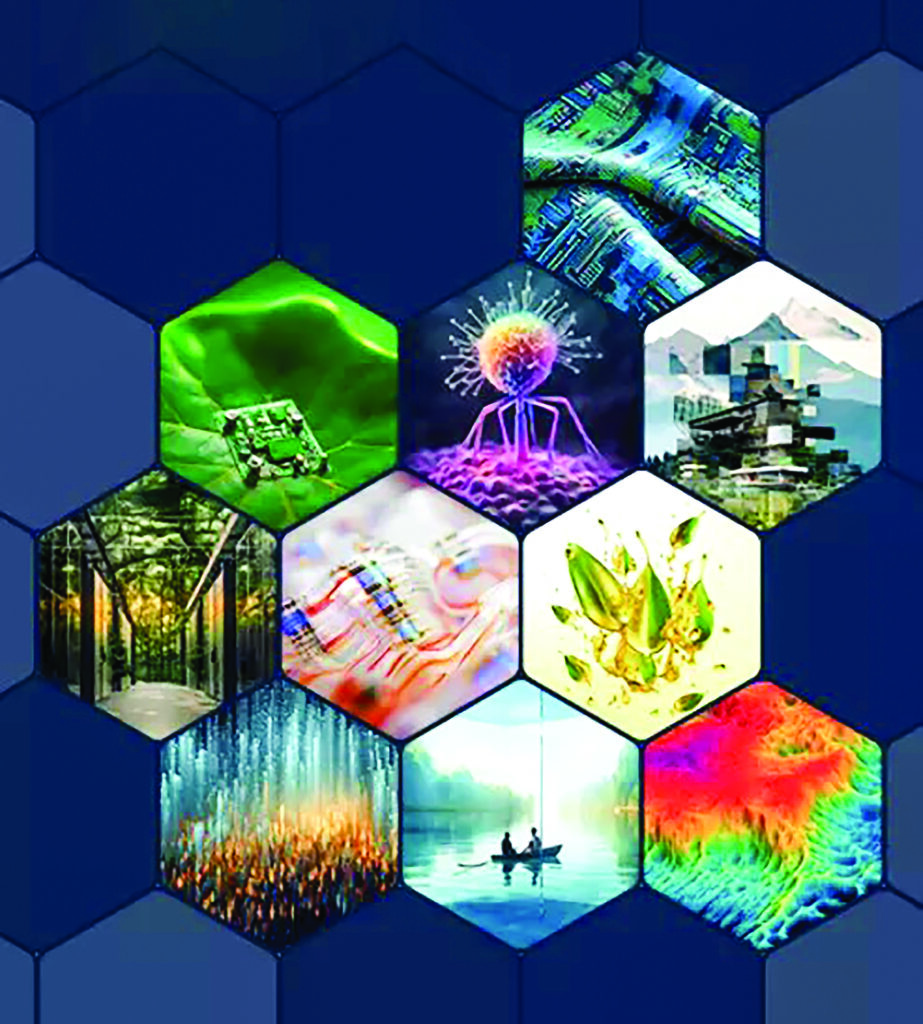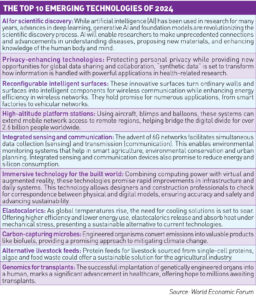NEW DELHI: While AI is being used in nearly every sector, in the near future AI itself will help discovery and breakthroughs.
A few months don’t pass by before the world is presented by even more impressive technology. The latest report of the World Economic Forum has identified a new list of top ten emerging tech.
The most impressive of these is the technology which will enable genetically grown organ to be implanted in a human body. While transplants have been possible for decades, the ability to create an organ could alter the entire dynamics of healthcare. The key challenges for transplants were availability of organs and suitability for the recipient.
While AI is being used in nearly every sector, in the near future AI itself will help discovery and breakthroughs. The WEF report says that AI is emerging as a transformative general-purpose technology in scientific research that can unearth discoveries that would have otherwise remained hidden. With the current rate of innovation, these are likely to lead to advances in the areas of diagnosis, treatment and prevention of diseases; novel materials that enable next-generation green technologies; breakthroughs in the life sciences that extend current understanding of biology; transformative leaps in how the human mind is understood, and many more (see box for entire list).
Many other fascinating technologies beyond this list are already in mainstream usage. Now consumers can let your own voice take your calls.
Smart phone app TrueCaller is now developing a digital voice feature that can take calls on behalf of the user. “The personal voice feature allows our users to use their own voice, enabling the digital assistant to sound just like them when handling incoming calls. This groundbreaking capability not only adds a touch of familiarity and comfort for the users but also showcases the power of AI in transforming the way we interact with our digital assistants,” Raphael Mimoun, Product Director & General Manager, Truecaller Israel. TrueCaller has partnered with Microsoft Azure for this feature.
This is the latest development among the various advances being made in voice technology. Voice management technology has come a long way from the 1980s, when answering machines were the only way to leave messages for callers.
In the age of AI, voice based solutions have created a vibrant market. The main factors driving the voice and speech recognition market growth include increasing demand for voice biometric systems for user authentication, and growth of speech recognition in-car voice and speech recognition systems, according to a report by Grandview Research. Growing adoption of voice-enabled applications in smartphones and the increasing use of voice and speech recognition in mobile banking, consumer electronics, and IoT devices will drive the demand, Grandview says.
From the current US$20.25 billion, the voice and speech recognition market is anticipated to more than double to over $53 billion with several global tech leaders and startups investing heavily in solutions. Google has developed the universal speech model that aims to recognize over 1,000 languages. Google says its automatic speech recognition can work not just on widely-spoken languages like English and Mandarin, but also on under-resourced languages like Amharic, Cebuano and Assamese.
Voice technology is becoming smarter with the use of AI. From personal digital assistants to smart speakers to voice based search, there are increasing application for this technology.
Apple has a suite of voice-based features. Users with cognitive disabilities can use iPhone and iPad with greater ease and independence with Assistive Access, Apple says. Individuals who can’t speak can type to speak during calls and conversations with Live Speech.
Apple also has a feature where those at risk of losing their ability to speak can use Personal Voice to create a synthesised voice that sounds like them for connecting with family and friends. “For users who are blind or have low vision, Detection Mode in Magnifier offers Point and Speak, which identifies text users point toward and reads it out loud to help them interact with physical objects such as household appliances,” an Apple statement says.
There are worries too. Many artists are already in conflict with technology companies who are using or copying their voices. Not just famous personalities like Scarlett Johansson, but many professionals including artists and voice actors are concerned about the impact of this technology. Frauds using fake voice are on the rise. Professionals have been fooled by callers whose voices sound like their superiors’. Many have lost money or taken decisions that have hurt them. Entire industries like voice, podcasts and movies can be transformed by AI generated voice. As in most technologies it will have a positive and negative impact.
Healthcare sector will see the most positive benefits from voice technologies. Voice has become a key biometric which can support and enable human activities in unprecedented ways. Companies in various industries are experimenting with voice including for customer engagement. As the speed of innovation and application accelerate, rules surrounding voice technology need to evolve rapidly for maximizing the benefits while minimizing harm.
Tremendous strides are being made in earth observation technology and agritech even as the world braces for rising climate turbulence.
Two recent reports by the World Economic Forum offer a roadmap for the future. Earth observation (EO) refers to collection of environmental data using remote sensing technologies. This information can be about activities and characteristics on Earth, both natural and artificial, including physical, chemical, biological and anthropogenic (human) systems as part of the overall ecology.
“Data collected from space and other sensors can benefit a wide range of business interests, both by strengthening financial performance and by supporting compliance with environmental regulations,” the WEF report says. “EO can play a helpful role in supporting organizations to advance climate and nature goals through verifying carbon reduction, understanding organizations’ impacts and dependencies on nature, and identifying strategies that contribute to a nature-positive and net-zero economy.”
Such information derived and deployed by the industry has the potential to drive $3.8 trillion in economic benefit while supporting climate change initiatives, the study says. Most impact will be in sectors like in agriculture, electricity and utilities, government, public and emergency services, insurance and financial services, mining, oil and gas, and supply chain and transport.
EO data can be classified into several categories. These include measuring geometry of natural and man-made structures; measure radio and ultraviolet radiation; identify species of vegetation; identify chemicals in land, water and greenhouses; and delineate shoreline and land coverage.
This information, properly processed and applied can help in consumer insights, supply chain monitoring, early warning and vulnerability analysis. The shipping industry can use EO data along with global navigation satellite systems, to dynamically plan and optimize sea routes. For example, the Finnish Meteorological Office uses data from the EU’s Copernicus programme to help ships navigate icy seas. Satellites and aircraft-borne sensors can monitor GHGs like CO2 and methane. The increasing precision of these platforms has been demonstrated to pinpoint emissions sources like oil and gas pipeline leaks, the study says.
A specialised satellite has been launched only to study the rise and impact of methane in earth’s atmosphere. The MethaneSat combines high spatial resolution imagery and a wide field of view to provide unprecedented precision in identifying and tracking methane emissions sources. Deeper and precise information will help governments to track source and take mitigation measures rapidly.
Another report by WEF focuses on agritech initiatives. “A number of agritech solutions have been available for almost a decade now, and have gone through a cycle of research, development, adoption and scale-up. However, to date these agritech services are yet to achieve scale when compared to the market potential that emerging economies offer,” the report says. Industry players are coming together under WEF’s AI for Agri Innovation platform to enhance the impact of agritech at scale.
The report includes two cases studies from India, Agri Stack, developed by the national Ministry of Agriculture and Farmer Welfare, and ADeX, developed by the state government of Telangana in collaboration with the WEF and the Indian Institute of Science. AgriStack facilitates digital services to farmers by the government, agritech start-ups, the private sector or other institutions by giving information on farmer identity; geotagged farm location; and crops-sown data. The ADeX platform is coupled with the Agriculture Data Management Framework, which lays out policy to enable the government to share data with the private sector once the farmer has given consent for it to do so.
Food industry is using bio-surveillance methods that use AI based sensors in farms to detect harmful chemicals in the soil. “Biosurveillance is a systematic process to survey the environment or location of interest for bacteria, fungi, viruses, or other biological entities that might cause disease in people, animals, or plants in support of detection and identification efforts and corresponding public health or safety,” according to the National Institute of Standards and Technology of US government. The Food Safety and Standards Authority of India has also been promoting the use of blockchain, AI and machine learning to food safety.
Society, businesses, and governments will have to continuously reassess the use of technologies in all functions. The adoption of new and rejection of old technologies will be much faster cycle.
Pranjal Sharma is an economic analyst and author of “The Next New: Navigating the Fifth Industrial Revolution”.




